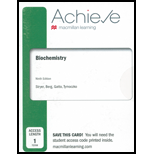
Concept explainers
(a)
Interpretation:
The most suitable matching pair of answers should be selected.
Concept introduction:
Photosynthesis is the process by which plants store energy of sunlight as chemical energy. Process happens in the chloroplast of a plant cell. Photosynthesis happens in two main stages - light reaction and dark reaction.
Answer to Problem 23P
- a) Calvin cycle − the dark reactions
Explanation of Solution
Photosynthesis happens via two main stages as light reaction and dark reaction. Light reaction happens in the presence of sunlight. Two photosystems called PS I and PS II absorbs energy of sun light. At the end of light reaction ATP, NADPH and O2 produce. Next, the dark reaction (which is also known as Calvin cycle) starts which uses ATP and NADPH.
For the dark reaction there is no need of sunlight which happens within the stroma. This is a series of
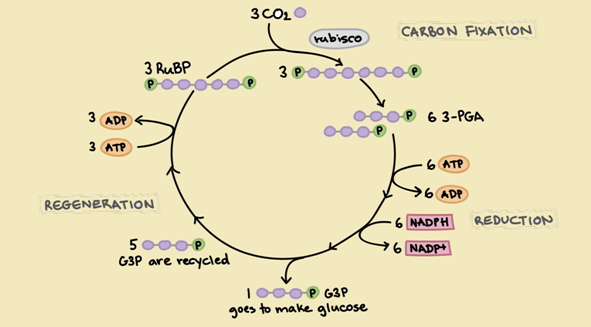
Figure 1: Calvin cycle
(b)
Interpretation:
The most suitable matching pair of answers should be selected.
Concept introduction:
Photosynthesis is the process by which plants store energy of sunlight as chemical energy. Process happens in the chloroplast of a plant cell. Photosynthesis happens in two main stages - light reaction and dark reaction.
Answer to Problem 23P
- b) Rubisco − catalyzes CO2 fixation
Explanation of Solution
Rubisco (Ribulose-1,5-bisphosphate carboxylase/oxygenase), is an enzyme used in the dark reaction of photosynthesis. It catalyzes the carbon fixation process where atmospheric carbon dioxide is converted to glucose by photosynthetic organisms..
The enzyme is capable of fixing both CO2 and O2. This enzyme is comparatively less efficient at low CO2 concentrations and tends to bind O2. This series of reactions start with O2 to finally produce CO2. The process is known as photorespiration.
(c)
Interpretation:
The most suitable matching pair of answers should be selected.
Concept introduction:
Rubisco activase enzyme is important in activating Rubisco. Rubisco (ribulose-1,5-bisphosphate carboxylase/oxygenase), is an enzyme used in the dark reaction of photosynthesis. It catalyzes the carbon fixation process where atmospheric carbon dioxide is converted to glucose.
Answer to Problem 23P
- c) Carbamate − required for the rubisco activity
Explanation of Solution
In plants and some types of green algae, an enzyme called RuBisCO activase is present. This is required to allow the rapid formation of carbamate in the active site of rubisco. RuBisCO activase is required because the ribulose 1,5-bisphosphate (RUBP) substrate binds more strongly to the active sites lacking carbamate and hence slows down the activation process.
(d)
Interpretation:
The most suitable matching pair of answers should be selected.
Concept introduction:
Starch is a
Answer to Problem 23P
- d) Starch − storage form of carbohydrates
Explanation of Solution
Starch is a polymeric carbohydrate produced by joining a large number of glucose units via glycosidic bonds.
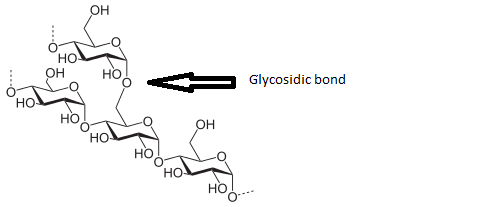
Figure 2: Structure of starch
After plants produce glucose by photosynthesis, it is stored in the cells as starch. Starch is insoluble in plant cell. So, unlike starch glucose increases the concentration of the plant cell.
(e)
Interpretation:
The most suitable matching pair of answers should be selected.
Concept introduction:
Sucrose is a disaccharide of Glucose and fructose, having twelve carbon atoms. Disaccharide consists of two monosaccharides, having six carbon atoms each.
Answer to Problem 23P
- a) Sucrose − transport form of carbohydrates
Explanation of Solution
Sucrose consists of a glucose molecule and a fructose molecule joined through a glycosidic bond.
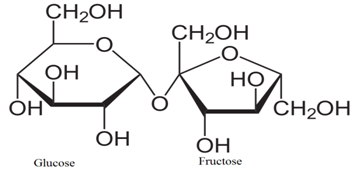
Figure 3: Structure of Sucrose
Plants store glucose (produced in photosynthesis) as starch in different places such as in fruits, seeds, and roots. Starch is insoluble in water and cannot be transported. When the plant needs energy, starch is converted to sucrose and transported. Even though glucose is soluble in water, plant does not convert starch to glucose. Since glucose is highly reactive compared to sucrose, it can transform into other intermediate compounds during transportation. Once it reaches the destination, sucrose is converted to glucose.
(f)
Interpretation:
The most suitable matching pair of answers should be selected.
Concept introduction:
Amylose is a polysaccharide made up of glucose units. These glucose molecules are bonded to each other through a (1→4) glycosidic bonds. Due to its tightly packed helical structure, amylose is resistant to digestive enzymes and therefore known as a resistant starch.
Answer to Problem 23P
- b) Amylose -
Explanation of Solution
As indicated in the figure, the first and fourth carbon of the glucose monomers react to form a bond between them. This bond is known as 1, 4 glycosidic bond.
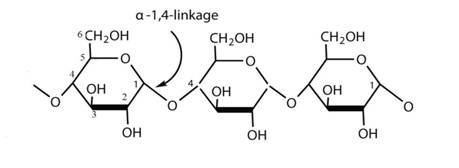
Figure 4: Structure of amylose
(g)
Interpretation:
The most suitable matching pair of answers should be selected.
Concept introduction:
Amylopectin is a highly branched
Answer to Problem 23P
- c) Amylopectin − includes
Explanation of Solution
Amylopectin is a highly branched polymer. This is also known as polysaccharide. The primary unit is glucose. Like amylose, the glucose units are linked in a linear way with a (11→4) glycosidic bonds. This
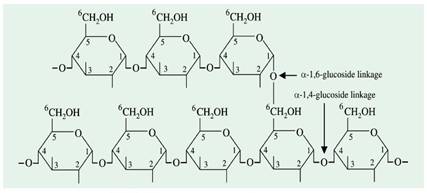
Figure 5: Structure of amylopectin
(h)
Interpretation:
The most suitable matching pair of answers should be selected.
Concept introduction:
Photosynthesis is the process by which plants store energy of sunlight as chemical energy. Process happens in the chloroplast of a plant cell. Photosynthesis happens in two main stages - light reaction and dark reaction. The dark reaction consists either of the two
Answer to Problem 23P
- d) C3 plants − 3 − Phosphoglycerate is formed after carbon fixation
Explanation of Solution
The dark reaction of photosynthesis consists of two metabolic pathways, that is, C3 and C4 cycle. All the green plant uses one of these two pathways. The nomenclature is based on the number of carbon atoms present in the first metabolite produced after CO2 fixation.
The first metabolite produced in C3 cycle composed of three carbons while a four carbon metabolite is produced in C4 cycle.
The light reaction is common to both C3 and C4 cycle. But the type of enzymes and intermediate produced during the dark reaction are different.
RUBP (Ribulose Bisphosphate) carboxylase is the enzyme of C3 cycle which fixes CO2, present in the atmosphere. After Co2 fixation, a five-carbon molecule, RUBP (Ribulose bisphosphate) reacts with CO2 to form a six-carbon complex. The six-carbon molecule break immediately and form two 3- phosphoglycerate. 3- phosphoglycerate consists of three carbon atoms.
So, this is the first stable product of CO2 fixation. This is the reason why the mechanism is known as C3 cycle.
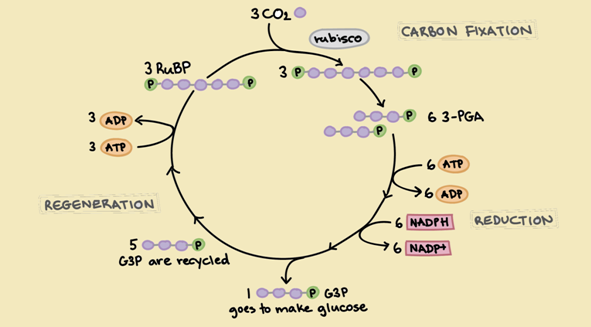
Figure 6: Calvin cycle of C3photosynthesis representing the carbon fixation.
(i)
Interpretation:
The most suitable matching pair of answers should be selected.
Concept introduction:
Photosynthesis is the process by which plants store energy of sunlight as chemical energy. Process happens in the chloroplast of a plant cell. Photosynthesis happens in two main stages - light reaction and dark reaction. The dark reaction consists either of the two metabolic pathways, that is, C3 and C4 cycle.
Answer to Problem 23P
- e) C4 plants − carbon fixation results in oxaloacetate formation
Explanation of Solution
The dark reaction of photosynthesis consists of two metabolic pathways, that is, C3 and C4 cycle. All the green plant uses one of these two pathways. The nomenclature is based on the number of carbon atoms present in the first metabolite produced after CO2 fixation.
As explained earlier, the first metabolite produced in C3 cycle composed of three carbons while a four-carbon metabolite is produced in C4 cycle.
Out of the two steps of photosynthesis (light and dark reaction), light reaction is common. But the type of enzymes and intermediate produced during the dark reaction are different.
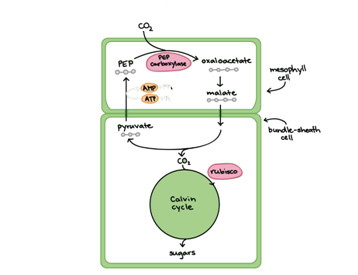
PEP (Phosphoenolpyruvate) carboxylase is the primary enzyme of C4 mechanism which catalyzes the fixation of CO2 in chloroplast. For this, a three-carbon molecule (PEP) reacts with CO2 to form a four-carbon molecule which is known as oxaloacetate. Oxaloacetate is the first stable product of C4 cycle.
This is the reason why the mechanism is called C4 mechanism. The reactions take place in mesophyll cells.
(j)
Interpretation:
The most suitable matching pair of answers should be selected.
Concept introduction:
Stomata are pores, found in the epidermis of leaves, stems, and other organs that facilitate gaseous exchange.
Answer to Problem 23P
- f) Stomata − allow exchange of gases
Explanation of Solution
Stomata are the pores which are mostly found in the epidermis of leaves and stems. It facilitates gaseous exchange. This stomatal pore is bordered by the guard cells which regulates the stomatal opening and closing.
Atmospheric air consists of carbon dioxide and oxygen enters the plant through these openings. These gases are crucial for photosynthesis and respiration, respectively. Also, water vapor releases to the atmosphere through the stomata. The process is known as transpiration.
So, stomata are the structures, present in the plant leaves crucial for all types of gaseous exchanges.
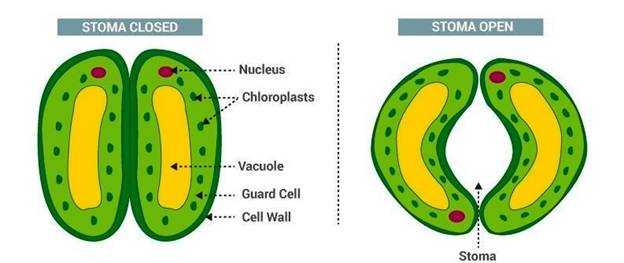
Figure 8: Microscopy view of stomata
Want to see more full solutions like this?
Chapter 20 Solutions
BIOCHEMISTRY-ACHIEVE (1 TERM)
- Please draw out the mechanism with curved arrows showing electron flow. Pyruvate is accepted into the TCA cycle by a “feeder” reaction using the pyruvate dehydrogenase complex, resulting in acetyl-CoA and CO2. Provide the mechanism for this reaction utilizing the TPP cofactor. Include the roles of all cofactors.arrow_forwardPyruvate is accepted into the TCA cycle by a “feeder” reaction using the pyruvate dehydrogenase complex, resulting in acetyl-CoA and CO2. Provide the mechanism for this reaction utilizing the TPP cofactor. Include the roles of all cofactors.arrow_forwardThe mitochondrial ATP synthase has 10 copies of the F0 subunit “c”, and the [H ] in the mitochondrial inner membrane space (IMS) is 6.31 x 10-8 M and the [H + ] in the matrix is 3.16 x 10-9 M. Calculate the minimum membrane potential (∆Ψ) necessary to make ATP synthesis thermodynamically favorable. [Assume ∆G' ofphosphate hydrolysis of ATP is - 45 kJ/mol.]arrow_forward
- B- Vitamins are converted readily into important metabolic cofactors. Deficiency in any one of them has serious side effects. a. The disease beriberi results from a vitamin B 1 (Thiamine) deficiency and is characterized by cardiac and neurological symptoms. One key diagnostic for this disease is an increased level of pyruvate and α-ketoglutarate in the bloodstream. How does this vitamin deficiency lead to increased serumlevels of these factors? b. What would you expect the effect on the TCA intermediates for a patient suffering from vitamin B 5 deficiency? c. What would you expect the effect on the TCA intermediates for a patientsuffering from vitamin B 2 /B 3 deficiency?arrow_forwardPyruvate is accepted into the TCA cycle by a “feeder” reaction using the pyruvate dehydrogenase complex, resulting in acetyl-CoA and CO2. Provide a full mechanism for this reaction utilizing the TPP cofactor. Include the roles of all cofactors.arrow_forwardMap out all of the metabolic pathways in the liver cell. Draw out the structures and names of all compounds neatly by hand and the pathways responsible for metabolizing them. Some examples are: Glycolysis/gluconeogenesis, PPP, Glycogenesis/glycogenolysis, Krebs, ETC, selectamino acid pathways (Ala, Glu, Asp) Lipogenesis/lipolysis. Citrate/MAS/glycerol phosphate shuttlesystems, and the Cori/Glc-Ala cycles. Rules:-Draw both a mitochondrial area of metabolism and a cytoplasmic area of metabolism.-Draw the liver and its roles in glucose recycling (Cori cycle/Glc-Alanine recycling)-Avoid drawing the same molecule twice (except for separate mitochondrial/cytoplasmic populations. i.e. Design the PPP/Glycolysis so that GAP is only drawn once)-Label Carbon 4 of glucose and highlight where you would expect to find it in EVERY compound in whichit is present.-Have one or two locations for NADH/NADPH/ATP/GTP/CoQH2 – many arrows will come to/from thesespots.arrow_forward
- a. Draw the Krebs Cycle and show the entry points for the amino acids Alanine,Glutamic Acid, Asparagine, and Valine into the Krebs Cycle. (Include name of Enzymes involved) b. How many rounds of Krebs will be required to waste all Carbons of Glutamic Acid as CO2? (Show by drawing out the mechanism that occurs)arrow_forwardThe malate-aspartate shuttle allows malate to be exchanged for aspartate acrossthe inner mitochondrial membrane. (a) Describe the role of the malate-aspartate shuttle in liver cells under HIGHblood glucose conditions. Be sure to explain your answer. (b) Describe the role of the malate-aspartate shuttle in liver cells under LOW blood + glucose conditions.arrow_forward(a) Write out the net reaction, calculate ∆E ̊' for the reaction, and calculate the standard free-energy change (∆G°') for the overall oxidation/reduction reaction. (h) How many moles of ATP could theoretically be generated per mole of FADH2 oxidized by this reaction, given a ∆G ̊' of ATP synthesis of + 31 kJ/mol? How many moles of ATP could be generated per mole of FADH2 oxidized by this reaction under more typical cellular conditions (where ∆G' of ATP hydrolysis is ~ -50 kJ/mol)? Be sure to show your work and explain your answer.arrow_forward
- Indicate for the reactions below which type of enzyme and cofactor(s) (if any) would be required to catalyze each reaction shown. 1) Fru-6-P + Ery-4-P <--> GAP + Sed-7-P2) Fru-6-P + Pi <--> Fru-1,6-BP + H2O3) GTP + ADP <--> GDP + ATP4) Sed-7-P + GAP <--> Rib-5-P + Xyl-5-P5) Oxaloacetate + GTP ---> PEP + GDP + CO26) DHAP + Ery-4-P <--> Sed-1,7-BP + H2O7) Pyruvate + ATP + HCO3- ---> Oxaloacetate + ADP + Piarrow_forwardThe phosphate translocase is an inner mitochondrial membrane symporter that transports H2PO4- and H+ into the mitochondrial matrix. Phosphate is a substrate for Complex V (the ATP Synthase), the enzyme that couples the synthesis of ATP to the H+ gradient formed by the electron transport chain. (a) Bongotoxin is a hypothetical compound that inhibits the phosphate translocase of the inner mitochondrial membrane. Explain why electron transport from NADH to O2 stops when bongotoxin is added to mitochondria (i.e., why do electrons stop flowing through the electron transport chain even with an abundance of NADH and O 2 present). What effect will the addition of the weak acid dinitrophenol (DNP) to the cytosol have on electron transport in bongotoxin-inhibited mitochondria? Be sure to explain your answers. (b) How much free energy is released (in kJ) when one mole of protons flows from the mitochondrial inner membrane space (IMS) to the mitochondrial matrix when the [H+ ] in the IMS is 7.9 x…arrow_forwardWhen TMPD/ascorbate is added to mitochondria as a source of electrons (TMPD/ascorbate reduce cytochrome c directly) oxygen is reduced to H2O by the electron transport chain (ETC).(a) Approximately how many ATPs would result per O2 consumed when electrons come from TMPD/ascorbate? (b) If dinitrophenol (DNP) is added to the mitochondria in (a) above, what effect would DNP have on the yield of ATPs per O2 reduced from TMPD/ascorbate electrons?arrow_forward
 Biology (MindTap Course List)BiologyISBN:9781337392938Author:Eldra Solomon, Charles Martin, Diana W. Martin, Linda R. BergPublisher:Cengage Learning
Biology (MindTap Course List)BiologyISBN:9781337392938Author:Eldra Solomon, Charles Martin, Diana W. Martin, Linda R. BergPublisher:Cengage Learning BiochemistryBiochemistryISBN:9781305577206Author:Reginald H. Garrett, Charles M. GrishamPublisher:Cengage Learning
BiochemistryBiochemistryISBN:9781305577206Author:Reginald H. Garrett, Charles M. GrishamPublisher:Cengage Learning Biology: The Dynamic Science (MindTap Course List)BiologyISBN:9781305389892Author:Peter J. Russell, Paul E. Hertz, Beverly McMillanPublisher:Cengage Learning
Biology: The Dynamic Science (MindTap Course List)BiologyISBN:9781305389892Author:Peter J. Russell, Paul E. Hertz, Beverly McMillanPublisher:Cengage Learning Anatomy & PhysiologyBiologyISBN:9781938168130Author:Kelly A. Young, James A. Wise, Peter DeSaix, Dean H. Kruse, Brandon Poe, Eddie Johnson, Jody E. Johnson, Oksana Korol, J. Gordon Betts, Mark WomblePublisher:OpenStax College
Anatomy & PhysiologyBiologyISBN:9781938168130Author:Kelly A. Young, James A. Wise, Peter DeSaix, Dean H. Kruse, Brandon Poe, Eddie Johnson, Jody E. Johnson, Oksana Korol, J. Gordon Betts, Mark WomblePublisher:OpenStax College Biology: The Unity and Diversity of Life (MindTap...BiologyISBN:9781305073951Author:Cecie Starr, Ralph Taggart, Christine Evers, Lisa StarrPublisher:Cengage Learning
Biology: The Unity and Diversity of Life (MindTap...BiologyISBN:9781305073951Author:Cecie Starr, Ralph Taggart, Christine Evers, Lisa StarrPublisher:Cengage Learning Biology 2eBiologyISBN:9781947172517Author:Matthew Douglas, Jung Choi, Mary Ann ClarkPublisher:OpenStax
Biology 2eBiologyISBN:9781947172517Author:Matthew Douglas, Jung Choi, Mary Ann ClarkPublisher:OpenStax





